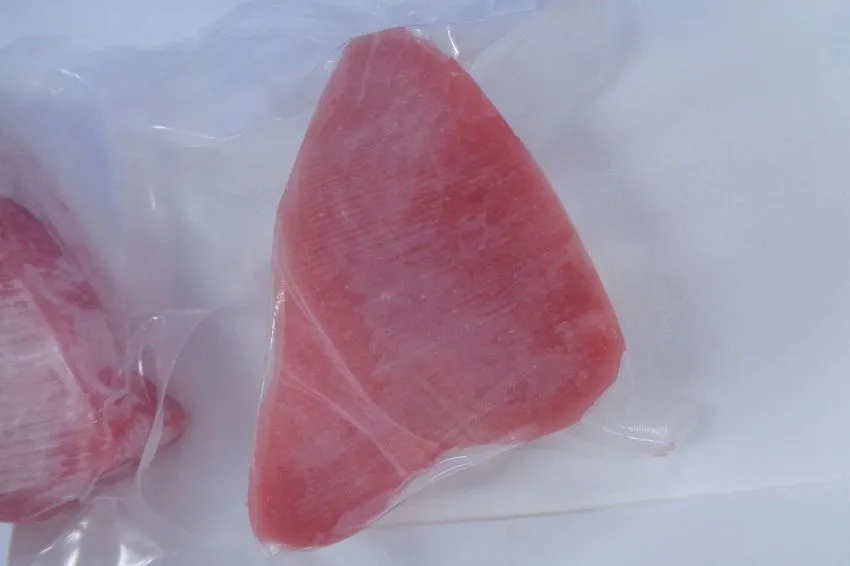Yellowfin tuna is a delicious and nutritious fish many people enjoy in various dishes.
As a popular choice for sushi and sashimi, the question of whether it’s safe to eat raw often arises. Yellowfin tuna can be consumed naturally as long as it has been handled and prepared correctly.
Summary
- Yellowfin tuna can be safely consumed raw with proper handling and preparation.
- Be aware of potential safety concerns, such as contamination and foodborne illness.
- Raw yellowfin tuna offers numerous health benefits, including protein and omega-3 fatty acids.
- Special populations, like pregnant women, should exercise caution when consuming raw tuna.
- Proper storage and preparation are crucial for maintaining the quality and safety of raw tuna dishes.
Can You Eat Yellowfin Tuna Raw?
You can indeed eat yellowfin tuna raw. It’s a popular ingredient in sushi and sashimi dishes. Yellowfin tuna, like other varieties such as bluefin, skipjack, and albacore, is safe to consume when served raw or nearly cooked. However, it’s essential to consider a few factors to ensure that you’re having a secure and delicious experience.
The first thing I’d consider is the freshness and quality of the tuna. Suppose you’re buying yellowfin tuna from a reputable store or restaurant.
In that case, they likely take the necessary precautions to serve safe and fresh raw fish. One such method is freezing the tuna before serving it plain, as this can help kill parasites that may be present in the fish.
Another aspect I’d keep in mind is the risk of mercury exposure. Like many other types of fish, tuna can contain traces of this heavy metal.
However, by consuming raw tuna in moderation and, preferably, choosing younger, smaller fish, you can minimize the potential health risks associated with mercury.
When enjoying raw yellowfin tuna, listening to your body and being cautious if you fall into any risk groups is essential.
Pregnant women, young children, and individuals with compromised immune systems should exercise caution and opt for cooked alternatives to ensure safety.
Is Raw Tuna Safe to Eat?
As someone who loves to consume raw fish, I recognize that there are safety concerns when eating raw yellowfin tuna. Let me discuss some of these issues in the following sub-sections.
Parasites
One primary concern when eating raw tuna is the risk of parasites. Anisakiasis is a common parasitic infection caused by eating raw fish, which can result in severe gastrointestinal problems.
To reduce the risk of parasites, I make sure that the tuna I consume has been previously frozen, as this kills most of the common parasites found in fish.
Mercury and Heavy Metals
Another concern while consuming raw yellowfin tuna is the presence of mercury and other heavy metals.
High mercury levels in fish often result from pollution and can lead to mercury poisoning. If I eat tuna frequently, I might be exposed to elevated levels of mercury, which may adversely affect my health, particularly my nervous system.
I follow the recommendation to limit my consumption of raw yellowfin tuna and choose fish with lower mercury content, such as salmon and sardines, to diversify my seafood intake.
Bacteria and Foodborne Illness
Eating raw fish, including yellowfin tuna, also has the potential risk of bacteria and foodborne illnesses.
Consuming raw fish increases my chances of food poisoning from bacteria like Salmonella or Vibrio.
To minimize this risk, I ensure that my raw tuna is fresh and comes from a reputable source. Proper handling and hygiene while preparing raw fish also significantly reduce the risk of bacterial contamination.
Selecting and Handling Raw Tuna
When it comes to enjoying raw yellowfin tuna, there are a few crucial factors to consider.
In this section, I’ll discuss the differences between fresh and frozen tuna, sushi-grade and sashimi-grade tuna, and how to buy and store raw tuna properly.
Fresh vs Frozen
Both fresh and frozen tuna can be used for raw consumption, but it’s essential to understand the differences.
Fresh tuna is typically purchased directly from a fish market or a grocery store with a high turnover, ensuring the fish is as fresh as possible.
On the other hand, frozen tuna is often flash-frozen at sea, which helps preserve its freshness.
Some prefer the taste of fresh tuna, but previously frozen tuna can be safely eaten raw. I find both options delicious as long as they are handled correctly.
Sushi-Grade vs Sashimi-Grade
When buying raw tuna, you may come across the terms “sushi-grade” and “sashimi-grade.” While no strict regulations define these terms, they generally indicate a higher quality fish.
Sushi-grade refers to fish that, after being properly treated, can be served in sushi rolls.
At the same time, sashimi-grade denotes fish suitable for sashimi, which is eaten without rice. When selecting raw tuna, looking for these labels can give me an added level of confidence in the quality and safety of the fish.
Buying and Storing Raw Tuna
To make sure I’m enjoying the best raw tuna possible, I follow these guidelines when buying and storing my fish:
- Purchase from a reputable source: I always buy raw tuna from a trusted fishmonger or a grocery store with high-quality seafood.
- Look for freshness: The tuna should have a firm texture and a bright, translucent color. I avoid fish with a strong, fishy smell.
- Transport safely: I ask for the tuna to be packed with ice or use a cooler to keep it cold during transit.
- Store properly: Once home, I place the raw tuna in the coldest part of my refrigerator, generally the bottom shelf, and plan to consume it within two days. If I need to store it for longer, I’ll wrap it tightly in plastic wrap and freeze it.
By following these tips, I’ve found it easy to enjoy delicious raw yellowfin tuna safely and responsibly.

Health Benefits of Eating Raw Tuna
As a fan of raw tuna, I want to share some of the health benefits of eating this delicious fish!
First, let’s talk about how raw yellowfin tuna is a fantastic source of protein. With nearly 7 grams of protein in just one ounce, it can be a great addition to a meal, especially for those looking to increase their protein intake.
One of my favorite aspects of raw tuna is its rich content of omega-3 fatty acids. These healthy fats are essential for maintaining heart health, reducing inflammation, and supporting brain function.
The Mayo Clinic suggests eating at least two servings of fish, including tuna, weekly to reduce the risk of heart disease.
Here are some other nutrients you can find in raw tuna:
- Vitamin B12 is essential for maintaining a healthy nervous system and producing red blood cells.
- Vitamin D: Helps with calcium absorption, promoting strong bones and teeth.
- Iron: Essential for carrying oxygen through the body.
- Selenium: An antioxidant that can help protect your body from cellular damage.
- Zinc: Supports the immune system, aiding in wound healing and cell growth.
- Potassium: Important for regulating fluid balance and maintaining nerve function.
Let me mention that eating raw tuna also has some potential risks. Please make sure the fish is fresh when consuming it.
Tuna that has been frozen or previously frozen should not be eaten raw, as this can lead to potential food poisoning.
When selecting tuna, always look for bright red or pink flesh free of brown spots or discoloration.
Special Populations and Considerations
Pregnant and Breastfeeding Women
As a concerned eater, I’ve learned that pregnant and breastfeeding women should be cautious when eating raw yellowfin tuna.
According to Healthline, raw fish consumption is not recommended for these women, as they may be more susceptible to foodborne illnesses.
It’s a good idea for them to consume cooked fish, which lowers the risk of contamination and provides essential nutrients for both mother and baby.
Children
When it comes to children, I also discovered that they should avoid eating raw yellowfin tuna.
Like pregnant and breastfeeding women, children develop immune systems and can be more vulnerable to infections from consuming raw fish.
Instead, providing cooked fish options can be a safer and healthier choice for their growing bodies.
Individuals with Weakened Immune Systems
Finally, people with weakened immune systems should also exercise caution while consuming raw yellowfin tuna.
These individuals, such as those undergoing cancer treatment or managing other health conditions, may be more susceptible to foodborne illness.
As a friendly suggestion, eating cooked fish rather than raw is a safer option for those with compromised immune systems.
To summarize, while raw yellowfin tuna can be a delicious and nutritious food for many, pregnant and breastfeeding women, children, and individuals with weakened immune systems should opt for cooked fish to ensure their safety and well-being.
Preparing Raw Tuna Dishes
As a fan of raw fish dishes, I’m excited to share some popular ways to enjoy fresh yellowfin (or ahi) tuna.
I’ll cover three delicious options: Poke Bowls, Sashimi, and Sushi Rolls. Remember that the key is to use high-quality, fresh tuna for the best experience.
Poke Bowls
This traditional Hawaiian dish has gained popularity worldwide in recent years. I love poke bowls because they’re both nutritious and delicious.
Here’s my simple guide to preparing a poke bowl with raw tuna steak:
- Start by dicing your fresh ahi tuna into small bite-sized cubes.
- Mix soy sauce, sesame oil, and green onions to make the marinade. Feel free to adjust the ingredients to your taste.
- Marinate the tuna in the fridge for at least 30 minutes, allowing the flavors to meld.
- Prepare your base, which can be rice, greens, or even quinoa. It’s entirely up to you!
- Assemble the bowl by combining the base, marinated tuna, and your favorite toppings like avocado, cucumber, or radish. I particularly enjoy some toasted sesame seeds as a garnish.
Sashimi
A classic Japanese delicacy, sashimi is a simple and elegant way to enjoy raw tuna.
Tuna sashimi is typically served as thin slices with soy sauce and wasabi on the side.
- You’ll want a high-quality, thawed raw tuna steak for this dish.
- Cut the tuna into even slices, approximately 1/4 inch thick.
- Neatly arrange the slices on a plate, leaving room for soy sauce, wasabi, and pickled ginger.
- Pro tip: You can elevate your sashimi by making a dipping sauce – mix soy sauce with a bit of wasabi, based on your spice tolerance.
Sushi Rolls
Lastly, let’s explore the world of sushi rolls! Incorporating raw tuna in sushi rolls lets you enjoy the subtle flavor and lean protein in a slightly more filling dish.
- I like to use a bamboo rolling mat for precise and easy rolling.
- Begin by placing a sheet of nori seaweed onto the mat.
- Spread sushi rice evenly on the nori, leaving a small border around the edges.
- Next, add a strip of raw tuna and any other ingredients you desire, like cucumber, avocado, or even a touch of spicy mayo.
- Roll tightly and gently press the mat to shape the sushi roll.
- Use a sharp knife to slice the roll into bite-sized pieces.
And there, you have three beautiful ways to enjoy raw yellowfin tuna! I hope you’ll enjoy preparing and indulging in these delicious dishes as much as I do.
FAQ
As someone who loves seafood, I’ve come across a common question: Can you eat yellowfin tuna raw?
To provide some answers, I’ve compiled a few frequently asked questions on this topic.
Yellowfin tuna can be enjoyed raw, but there are some risks to be aware of. Raw fish, including tuna, may contain parasites such as Opisthorchiidae and Anisakadie that can cause diseases. The general consensus is that if the tuna has been previously frozen, it may be safely eaten raw; however, if the tuna is fresh, it’s best to cook it first.
Yellowfin tuna is packed with nutrients. One ounce of raw yellowfin tuna contains nearly 7 grams of protein, no carbs, and a small amount of healthy fat. Tuna, like salmon, is rich in omega-3 fatty acids that have been shown to have various health benefits. Additionally, tuna is an excellent source of vitamins like D and B12, which help in forming new blood cells and preventing anemia.
The FDA/EPA advises that you can consume 1 serving a week of fish from the “Good Choices” category, which includes yellowfin tuna. Remember not to have any other fish that week as it’s essential to maintain a balanced diet.





Leave a Reply
You must be logged in to post a comment.